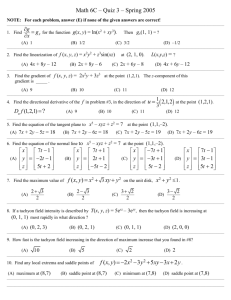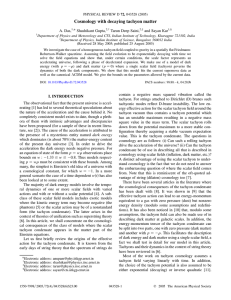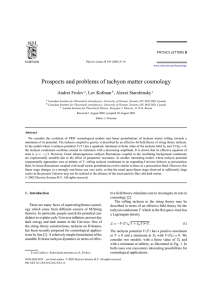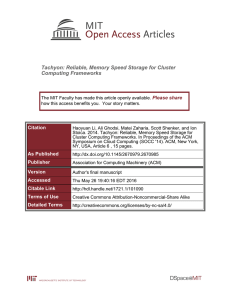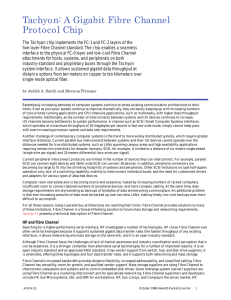The stability of tachyonic field system by factorization method
advertisement
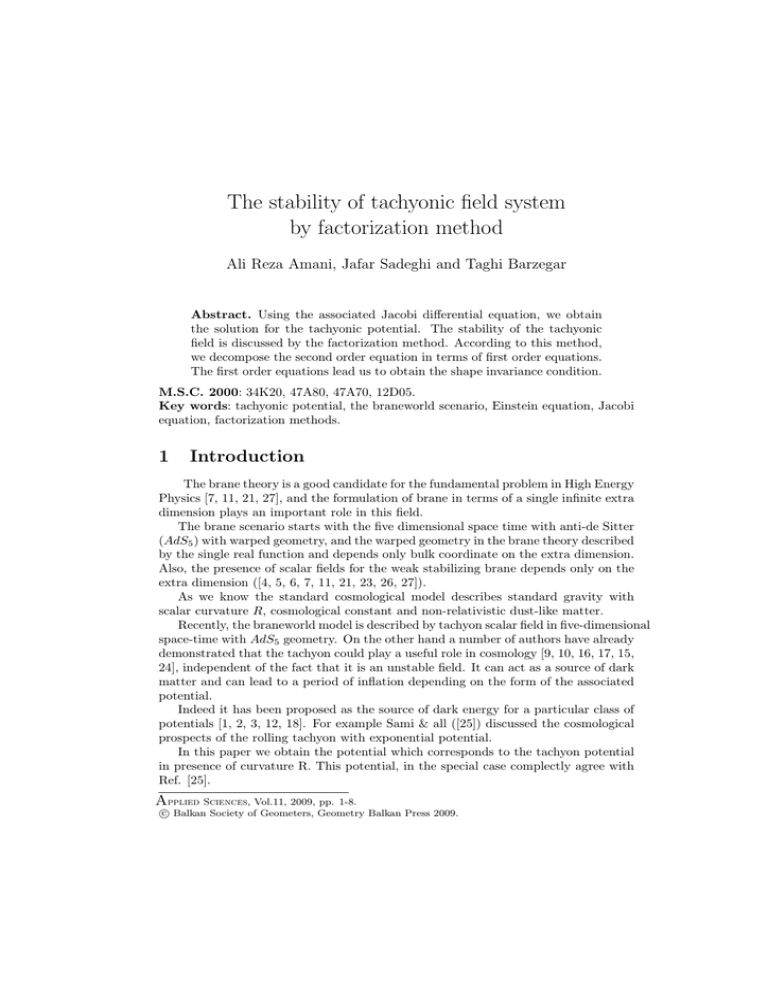
The stability of tachyonic field system by factorization method Ali Reza Amani, Jafar Sadeghi and Taghi Barzegar Abstract. Using the associated Jacobi differential equation, we obtain the solution for the tachyonic potential. The stability of the tachyonic field is discussed by the factorization method. According to this method, we decompose the second order equation in terms of first order equations. The first order equations lead us to obtain the shape invariance condition. M.S.C. 2000: 34K20, 47A80, 47A70, 12D05. Key words: tachyonic potential, the braneworld scenario, Einstein equation, Jacobi equation, factorization methods. 1 Introduction The brane theory is a good candidate for the fundamental problem in High Energy Physics [7, 11, 21, 27], and the formulation of brane in terms of a single infinite extra dimension plays an important role in this field. The brane scenario starts with the five dimensional space time with anti-de Sitter (AdS5 ) with warped geometry, and the warped geometry in the brane theory described by the single real function and depends only bulk coordinate on the extra dimension. Also, the presence of scalar fields for the weak stabilizing brane depends only on the extra dimension ([4, 5, 6, 7, 11, 21, 23, 26, 27]). As we know the standard cosmological model describes standard gravity with scalar curvature R, cosmological constant and non-relativistic dust-like matter. Recently, the braneworld model is described by tachyon scalar field in five-dimensional space-time with AdS5 geometry. On the other hand a number of authors have already demonstrated that the tachyon could play a useful role in cosmology [9, 10, 16, 17, 15, 24], independent of the fact that it is an unstable field. It can act as a source of dark matter and can lead to a period of inflation depending on the form of the associated potential. Indeed it has been proposed as the source of dark energy for a particular class of potentials [1, 2, 3, 12, 18]. For example Sami & all ([25]) discussed the cosmological prospects of the rolling tachyon with exponential potential. In this paper we obtain the potential which corresponds to the tachyon potential in presence of curvature R. This potential, in the special case complectly agree with Ref. [25]. Applied Sciences, Vol.11, 2009, pp. 1-8. c Balkan Society of Geometers, Geometry Balkan Press 2009. ° 2 Ali Reza Amani, Jafar Sadeghi and Taghi Barzegar The stability of the system and the property of shape invariance are considered in correspondence with the Schrödinger equation by the tachyonic potential. We obtain the normal mode of the system by factorization method [8, 13, 14, 22]. But the shape invariance is just an integrability condition - an interesting feature in supersymmetric quantum mechanics, and the entire modes of system can be determined algebraically without ever refereing to underlying differential equations [23, 26]. The paper is organized as follows. In the next section we study the dynamics of the tachyon to solve the tachyon potential. The equations of motion are presented and the Einstein equations are discussed. By using the equation of motion and Einstein equation we obtain the warp factor, which leads us to obtain the corresponding potential for the tachyon field. In section 3, normal modes of tachyon system are obtained in the Schrödinger equation by the associated Jacobi differential equation. In section 4, we factorize the corresponding second order differential equation and obtain raising and lowering operators with respect to m ([19, 20]). A summary and an outlook are given in the conclusion. 2 The dynamics of the tachyon The standard braneworld scenario is described by the real scalar field interaction with gravity via the usual Einstein Hilbert action, which has the general form, µ ¶ Z 1 √ 4 (2.1) S = d xdy g − R + LT , 16πG where R is the scalar curvature. We now turn attention to the case of the tachyonic field. We consider that tachyons dominate in univese. In this case, the Lagrange density is given by, p (2.2) LT = −V (T (y)) 1 − ∂µ T ∂ µ T , where T is the tachyon field, and V (T ) is the tachyonic field potential. In this theory the line element is given by (2.3) dS52 = e2A(y) ηµν dxµ dxν − dy 2 , where e2A(y) is the warp factor and A(y) is the real function of the extra dimension, which gives rise to the warped geometry, and η = diag(+ − −−) describes the fourdimensional flat space-time with µ, ν = 0, 1, 2, 3. The geometry of the five dimensional space-time is then described by A(y) and is driven by the extra coordinate y. We consider the tachyon action and suppose that the tachyon field only depends on the extra dimension, that is, T = T (y). The variation of the action with respect to the field leads to the following equation of motion, µ ¶ VT (2.4) T 00 (y) + 4A0 (y)T 0 (y) + (1 − T 02 ) = 0, V (T ) where VT = dV dT . The Einstein equation is then (2.5) 8πG 1 Rµν − gµν R = 4 Tµν , 2 c The stability of tachyonic field system by factorization method 3 where Rµν is the Ricci tensor, R = g µν Rµν is the Ricci scalar, the metric of the five dimensional is gµν = diag(e2A , −e2A , −e2A , −e2A , −1) and Tµν is the energymomentum tensor. We can simply consider 4πG = 1 and c = 1. We are also using the following energy - momentum tensor corresponding to the LT given by (2.2), √ 2 δ( gL) (2.6) Tµν = √ , g δg µν so, we can obtain the following equations, p T00 = e2A(y) V (T ) 1 − T 02 (2.7) p T11 = T22 = T33 = −e2A(y) V (T ) 1 − T 02 −V (T ) . T44 = √ 1 − T 02 The components of the Ricci tensor are, ¢ ¡ R00 = 4A02 + A00 e2A ¡ ¢ R11 = R22 = R33 = − 4A02 + A00 e2A (2.8) ¡ ¢ Rµν = ηµν e2A 4A02 + A00 ¡ ¢ R44 = −4 A02 + A00 , thus, the Ricci scalar is given by, (2.9) R(y) = 20A02 + 8A00 , where R is in term of y. We substitute the above results into equation (2.5) to obtain the two equations, using (2.5), (2.7) and (2.8) one can obtain, p ¢ 1 1 ¡ 02 (2.10) 4A + A00 − R = V 1 − T 02 , 2 4 and (2.11) ¡ ¢ 1 V 2 A02 + A00 − R = √ . 4 1 − T 02 The solution of the equations (2.10) and (2.11) lead us to obtain T 02 and V, (2.12) T 02 = 8(A00 6A00 , + A02 ) − R and (2.13) V = 3 0p A R − A02 . 2 In the presence of the scalar field, we consider the specific case when R is constant. So that we can obtain A0 (y) from (2.9) as follows, (2.14) A0 (y) = 2 γ tanh(γy), 5 4 Ali Reza Amani, Jafar Sadeghi and Taghi Barzegar √ where γ = 45R . By using (2.13) and (2.14), the corresponding potential for the tachyon field will be, q 12γ 2 (2.15) V (y) = tanh(γy) 5 − tanh2 (γy). 25 Now we draw V with respect to y, in that case this graph will be equivalent to the following equation, (2.16) V (y) = η tanh(γy), so η will become the functional of R. The graphs of the potentials (2.15) and (2.16) are kink-like. 3 The stability of the system and the normal mode The corresponding Schrödinger equation for the tachyonic potential (2.15) can be easily written as, (3.1) − d2 Ψ(y) + V (y)Ψ(y) = k 2 Ψ(y), dy 2 and (3.2) ¢ d2 Ψ(y) ¡ 2 + k − η tanh(γy) Ψ(y) = 0, 2 dy α,β With the definition of variable x = tanh(γy) and Ψ(x) = Pn,m (x)U (x), we obtain the following Schrödinger equation, " # 0 2 00 2 2 U (x) 0 (1 − x )Pn,m (x)dx + 2(1 − x ) − 2x Pn,m (x) U (x) # (3.3) " 00 0 U (x) k2 ηx 2 U (x) + (1 − x ) − 2x + 2 − Pn,m (x) = 0, U (x) U (x) γ (1 − x2 ) γ 2 (1 − x2 ) α,β where Pn,m (x) = Pn,m (x). Also here, in order to obtain the parameters, the eigenfunction and the normal mode for the tachyon potential, we compare (3.3) with the following associated Jacobi differential equation ([8, 13, 14, 22]), (3.4) 00 0 (1 − x2 )Pn,m (x) − [α − β + (α + β + 2)x] Pn,m ¸ · m(α + β + m + (α − β))x Pn,m (x) = 0. + n(α + β + n + 1) − 1 − x2 We compare (3.3) and (3.4), and obtain U (x) and k 2 as follows, (3.5) U (x) = (−1) α+β 2 α β (1 − x) 2 (1 + x) 2 , The stability of tachyonic field system by factorization method and 5 · ¸ (β − α)2 k 2 = −γ 2 m(α + β + m) + 4 · ¸ α+β +m η = −γ 2 (β − α) 2 (3.6) α + β = 0. Finally, we obtain the solution of equation for the corresponding tachyon potential, (3.7) Ψ(y) = (−1) α+β 2 β α (1 − tanh(γy)) 2 (1 + tanh(γy)) 2 Pn,m (tanh(γy)). As well, we infer the normal mode, k 2 = −γ 2 (m2 + β 2 ) = − (3.8) 5R 2 (m + β 2 ). 16 We note that the stability of system is satisfied assuming the condition (k 2 > 0), so we have R < 0. In that case, for the negative R case (2.9) is written as, −R = 20A02 + 8A00 , (3.9) so that we can obtain A0 (y) in the form, 2 A0 (y) = − γ tanh(γy). 5 (3.10) In that case the graph of the corresponding potential will be anti-kink. 4 The factorization method and shape invariance As follows from [8, 13, 14, 22], any second order equation which has an exact solution or a normal mode can be factorized in terms of first order equations. These first order equations lead us to have raising and lowering operators. These first operators give us the shape invariance condition. As we know, the associated Jacobi differential equation can be factorized by ladder and lower operators with respect to the parameter m as [13, 14], (4.1) − A+ m (x)Am (x)Pn,m (x) = En,m Pn,m (x), (4.2) + A− m (x)Am (x)Pn,m−1 (x) = En,m Pn,m−1 (x), where (4.3) (4.4) A+ m (x) = A− m (x) = − p p 1 − x2 1 − x2 d (m − 1)x , + √ dx 1 − x2 (α − β) + (α + β + m)x d √ + , dx 1 − x2 6 Ali Reza Amani, Jafar Sadeghi and Taghi Barzegar (4.5) En,m = (n − m + 1)(α + β + n + m). On the other hand, by comparing the Jacobi differential equation with the tachyonic equation we replace (3.6) into (4.3) and (4.4), and we get, (4.6) A+ m (x) = (4.7) A− m (x) = − p p 1 − x2 1 − x2 d (m − 1)x + √ , dx 1 − x2 d η + m2 γ 2 x √ + . dx mγ 2 1 − x2 If we express the above equations with respect to y, so we obtain · ¸ 1 1 d + + (m − 1) tanh(γy) , (4.8) Am (y) = q γ dy 1 − tanh2 (γy) (4.9) A− m (y) = q 1 1 − tanh2 (γy) · − ¸ 1 d η + + m tanh(γy) . γ dy mγ 2 We remark that (4.8) and (4.9) are first order equations and correspond to (3.2). It is interesting to link these first order operators to the generators of the N = 2 algebra. 5 Conclusions In this paper, we have discussed the tachyon field and obtained the corresponding potential in the braneworld scenario. We solved the corresponding potential in the case of constant curvature. Also, we calculated the energy spectrum (normal mode) and bound states of energy and obtained the stability of system in the case of negative curvature. Using the factorization method, we derived some laddering operators. The investigation of the shape invariance condition will be an interesting problem in future. References [1] L.R. Abramo, F. Finelli, Cosmological dynamics of the tachyon with an inverse power-law potential, Phys. Lett. B, 575 (2003), 165-171. [2] J.M. Aguirregabiria and R. Lazkoz,Tracking solutions in tachyon cosmology, Phys. Rev. D, 69 (2004), 123502-5. [3] J.S. Bagla, H.K. Jassal and T. Padmanabhan, Cosmology with tachyon field as dark energy, Phys. Rev. D, 67 (2003), 063504-11. [4] D. Bazeia and A.R. Gomes, Bloch brane , JHEP, 05 (2004), 012-13. [5] D. Bazeia, F.A. Brito and L. Losano, Scalar fields, bent branes, and RG flow, JHEP, 11 (2006), 064-23. [6] A. Campos, Critical phenomena of thick branes in warped spacetimes, Phys. Rev. Lett., 88 (2002), 141602-4. The stability of tachyonic field system by factorization method 7 [7] O. DeWolf, D.Z. Freedman, S.S. Gubser and A. Karch, Modeling the fifth dimension with scalars and gravity, Phys. Rev. D, 62 (2000), 046008-16. [8] H. Fakhri and J. Sadeghi, Supersymmetry approaches to the bound states of the generalized Woods-Saxon potential, Mod. Phys. Lett. A, 19 (2004), 615-625. [9] A. Feinstein, Power-law inflation from the rolling tachyon, Phys. Rev. D, 66 (2002), 063511-3. [10] G.W. Gibbons, Cosmological evolution of the rolling tachyon , Phys. Lett. B, 537 (2002), 1-4. [11] W.D. Goldberger and M.B. Wise, Modulus stabilization with bulk fields, Phys. Rev. Lett., 83 (1999), 4922-4925. [12] Z.K. Guo and Y.Z. Zhang, Cosmological scaling solutions of multiple tachyon fields with inverse square potentials, JCAP, 08 (2004), 010-10. [13] M.A. Jafarizadeh and H. Fakhri, Supersymmetry and shape invariance in differential equations of mathematical physics, Phys. Lett. A, 230 (1997), 164-170. [14] M. A. Jafarizadeh and H. Fakhri, Parasupersymmetry and shape invariance in differential equations of mathematical physics and quantum mechanics, Ann. Phys. (N.Y.), 262 (1998), 260-276. [15] L. Kofman and A. Linde, Problems with Tachyon Inflation, JHEP, 07 (2002), 004-12. [16] R. Koley and S. Kar, A novel braneworld model with a bulk scalar field , Phys. Lett. B, 623 (2005), 244-250. [17] L. Leblond and S. Shandera , Cosmology of the tachyon in brane inflation, JCAP, 01 (2007), 009-31. [18] T. Padmanabhan, Accelerated expansion of the universe driven by tachyonic matter, Phys. Rev. D, 66 (2002), 021301-4. [19] R.T. Matoog and A.-F. K. Bukhari, Solution of the system of differential equations related to Marangoni convections in one fluid layer, Balkan Jour. Geom. Appl. (BJGA), 10 (2008), 143-161. [20] A. Olteanu and O. Olteanu, Solving some functional and operational equations, Balkan Jour. Geom. Appl. (BJGA), 10 (2008), 193-198. [21] L. Randall and R. Sundrum, An Alternative to Compactification, Phys. Rev. Lett., 83 (1999), 4690-4693. [22] J. Sadeghi, Superalgebras for three interacting particles in an external magnetic field, Eur. Phys. J. B, 50 (2006), 453-457. [23] J. Sadeghi and A. Mohammadi, Shape invariance for the bent brane with two scalar fields, Eur. Phys. J. C, 49 (2007), 859-864. [24] M. Sami, Implementing power law inflation with tachyon rolling on the brane, Mod. Phys. Lett. A, 18 (2003), 691-697. [25] M. Sami, P. Chingangbam and T. Qureshi, Cosmological aspects of rolling tachyon, Pramana, 62 (2004), 765-768. [26] M. R. Setare, J. Sadeghi and A. R. Amani, Shape invariance method for quintom model in the bent brane background, Phys. Lett. B, 660 (2008) 299-306. [27] K. Skenderis and P. K. Townsend, Gravitational stability and renormalizationgroup flow, Phys. Lett. B, 468 (1999), 46-51. 8 Ali Reza Amani, Jafar Sadeghi and Taghi Barzegar Authors’ addresses: Ali Reza Amani Department of Physics, Islamic Azad University-Ayatollah Amoli Branch, P. O. Box 678, Amol, Mazandaran, Iran. E-mail: a.r.amani@iauamol.ac.ir Jafar Sadeghi and Taghi Barzegar Faculty of Basic Sciences , Departments of Physics, Mazandaran University, P. O. Box 47415-416, Babolsar, Iran. E-mail: pouriya@ipm.ir, barzegar@umz.ac.ir

